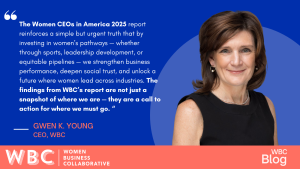
Women CEOs Matter—and What the 2025 Women CEOs in America Report Reveals
October 1, 2025

In 2025, the business world faces both urgent challenges and fresh opportunities: heightened scrutiny of equity, evolving workforce expectations, and accelerating demands for innovation and resilience. In this moment, women CEOs aren’t just a matter of fairness — they are central to organizations that want relevance, agility, and legitimacy.
The latest Women CEOs in America 2025 report from Women Business Collaborative underscores not just how far we’ve come, but how strategically important it is to speed up our progress. (PR Newswire)
This is where the work of WBC becomes not just important—but urgent.
Snapshot: Still Way Too Few Women CEOs
According to the 2025 report, women currently average 9.2% of CEOs across the Fortune 1000, S&P 500, Russell 3000, and private firms over $1B in revenue. This is both a milestone and a reminder: progress is steady but incremental.
In the Fortune 500 alone, women now lead 55 companies, about 11% of all CEOs in that group. That indicates growth, but also points to the vast equity gap at the top of corporate America. Growth is simply not happening fast enough.
This year’s report adds a new dimension to the narrative: 10.2% of women CEOs have a background in competitive athletics (collegiate, professional, or elite-level). That data suggests the qualities honed in sports — discipline, persistence, strategic thinking, teamwork, composure under pressure —bring real value to executive leadership roles.
Why Women CEOs Are Critical Now
- Driving Business Performance And Innovation
In a complex, fast-changing environment, firms led by women are better able to navigate ambiguity with broader perspectives. Numerous studies correlate gender-diverse executive teams with stronger financial performance, better risk management, and greater innovation. - Closing the Legitimacy Gap
Organizations that reflect their employees, customers, and communities in their leadership are more trusted and resilient. Women are 50% of the U.S. workforce and drive 70–80% of consumer purchasing decisions. As movements for racial, gender, and social equity intensify, having women at the top is a crucial signal that leadership is inclusive, grounded, and credible. - Harnessing Leadership Qualities Honed in Sports
When women with athletic experience ascend to the C-Suite, they bring mindsets forged in competition: resilience in setbacks, an orientation toward goals, adaptability and the ability to lead under pressure. These traits are not soft skills — they are core capabilities for transformation. - Accelerating the CEO Pipeline
Representation at the top matters, but so does the pipeline. By focusing on women in earlier leadership roles — for example, ensuring more women are considered for CEO roles — organizations can begin to shift hiring, development, and succession systems structurally. WBC has also identified targets around women in line roles, P&L responsibilities, and C-Suite positions as key levers for change.
Findings to Watch and Leverage
- Sector Concentration: The report notes that 62% of the women CEOs with athletic backgrounds are in healthcare, consumer goods, and technology — sectors that prize performance and adaptability.
- Athletic background as a differentiator: While only about one in ten women CEOs have athletic experience, that shared athletic participation and resulting characteristic traits are powerful in signaling alternative or advancing pathways to leadership.
- Stagnant gains in some indexes: The overall share of women CEOs across major indices remains under 10%, demonstrating both incremental progress and persistent structural barriers. We need to accelerate this progress.
Final Word: Action
The Women CEOs in America 2025 report reinforces a simple but urgent truth: women at the top matter. By investing in women’s pathways — whether through sports, leadership development, or equitable pipelines — we don’t just chase parity. We strengthen business performance, deepen social trust, and unlock a future where women lead across industries. The findings from WBC’s report are not just a snapshot of where we are — they are a call to action for where we must go.
Author
-

Gwen K. Young is the CEO of the Women Business Collaborative. She is also a Visiting Scholar at the Elliot School of International Affairs, George Washington University and former Director of the Global Women’s Leadership Initiative at the Wilson Center. She is an Advisor to Concordia. Ms. Young has worked across the globe to promote economic development, good governance and peace. She has developed strategy, programming and advocacy in the areas of humanitarian policy, international affairs and international development. This includes developing public private partnerships focused on public health, agriculture, gender equality, and access to finance. Further, Ms. Young has advocated for and published on international criminal law and designed SGBV guidelines. As an attorney, Ms. Young has worked as a professional advocate for women and human rights in corporate law settings, with the ICTY and the Kroc Institute for Peace and Justice at the University of San Diego. Her career has encompassed a comprehensive array of international organizations including the Bill & Melinda Gates Foundation, Medecins Sans Frontieres, International Rescue Committee, and the Harvard Institute for International Development. An alumna of Smith College, Harvard’s Kennedy School of Government and the University of California Davis, School of Law, Ms. Young has pursued a career of international public service focused on humanitarian relief, international development, and human rights starting with gender equality and equity.
View all posts

